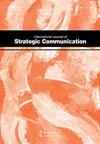考察COVID-19期间世卫组织在问题领域的危机沟通:社会语义网络分析
IF 1.9
Q1 COMMUNICATION
International Journal of Strategic Communication
Pub Date : 2022-08-08
DOI:10.1080/1553118X.2022.2058400
引用次数: 1
摘要
COVID-19给公共卫生监管机构和专家在应对危机沟通方面提出了若干挑战。世界卫生组织在处理危机沟通方面的作用受到了审查,并在推特上就COVID-19信息展开了辩论。本研究从问题领域和传播网络理论的角度,探讨了世界卫生组织(WHO)在COVID-19信息传播中的延迟及其对疫情传播的影响。它考察了由于世卫组织采用的沟通和危机应对策略而在Twitter上出现的行动者、话题和情绪。调查结果揭示了五个主要行为者——组织、媒体、独立用户、政治行为者和其他;舞台上的主导情绪,如期待、愤怒、恐惧和信任。此外,世卫组织还采用了由加强措施支持的最小化和纠正行动战略。通过在虚拟空间中引入社会语义网络的新语境,本研究在关注健康传播、公共关系和危机传播的同时,揭示了战略传播。这些见解和发现可以帮助组织在危机期间缓和和管理问题。本文章由计算机程序翻译,如有差异,请以英文原文为准。
Examining WHO’s Crisis Communication in Issue Arenas during COVID-19: A Socio-semantic Network Analysis
ABSTRACT COVID-19 has posed several challenges to public health regulatory bodies and experts in dealing with crisis communication. The World Health Organization’s role in dealing with crisis communication came under scrutiny and opened a debate on Twitter regarding COVID-19 information. This study investigates the delay in the dissemination of information on COVID-19 by the World Health Organization (WHO) and its effects on communication about the pandemic through the lens of issue arenas and communication network theories. It examines the actors, topics, and sentiments that emerged in Twitter because of the communication as well as the crisis response strategies adopted by the WHO. The findings reveal five main actors – organizations, media, independent users, political actors, and others; the dominant emotions in the arena such as anticipation, anger, fear, and trust. Additionally, the WHO employs minimization, and corrective action strategies supported by bolstering. By introducing a new context to the socio-semantic network in the virtual space, this study sheds light on strategic communication while focusing on health communication, public relations, and crisis communication. These insights and findings can help organizations to moderate and manage issues during crises.
求助全文
通过发布文献求助,成功后即可免费获取论文全文。
去求助
来源期刊

International Journal of Strategic Communication
Social Sciences-Sociology and Political Science
CiteScore
3.40
自引率
0.00%
发文量
39
期刊介绍:
The International Journal of Strategic Communication examines the philosophical, theoretical, and applied nature of strategic communication, which is “the purposeful use of communication by an organization to fulfill its mission.” IJSC provides a foundation for the study of strategic communication from diverse disciplines, including corporate and managerial communication, organizational communication, public relations, marketing communication, advertising, political and health communication, social marketing, international relations, public diplomacy, and other specialized communication areas. The IJSC is the singular forum for multidisciplinary inquiry of this nature.
 求助内容:
求助内容: 应助结果提醒方式:
应助结果提醒方式:


